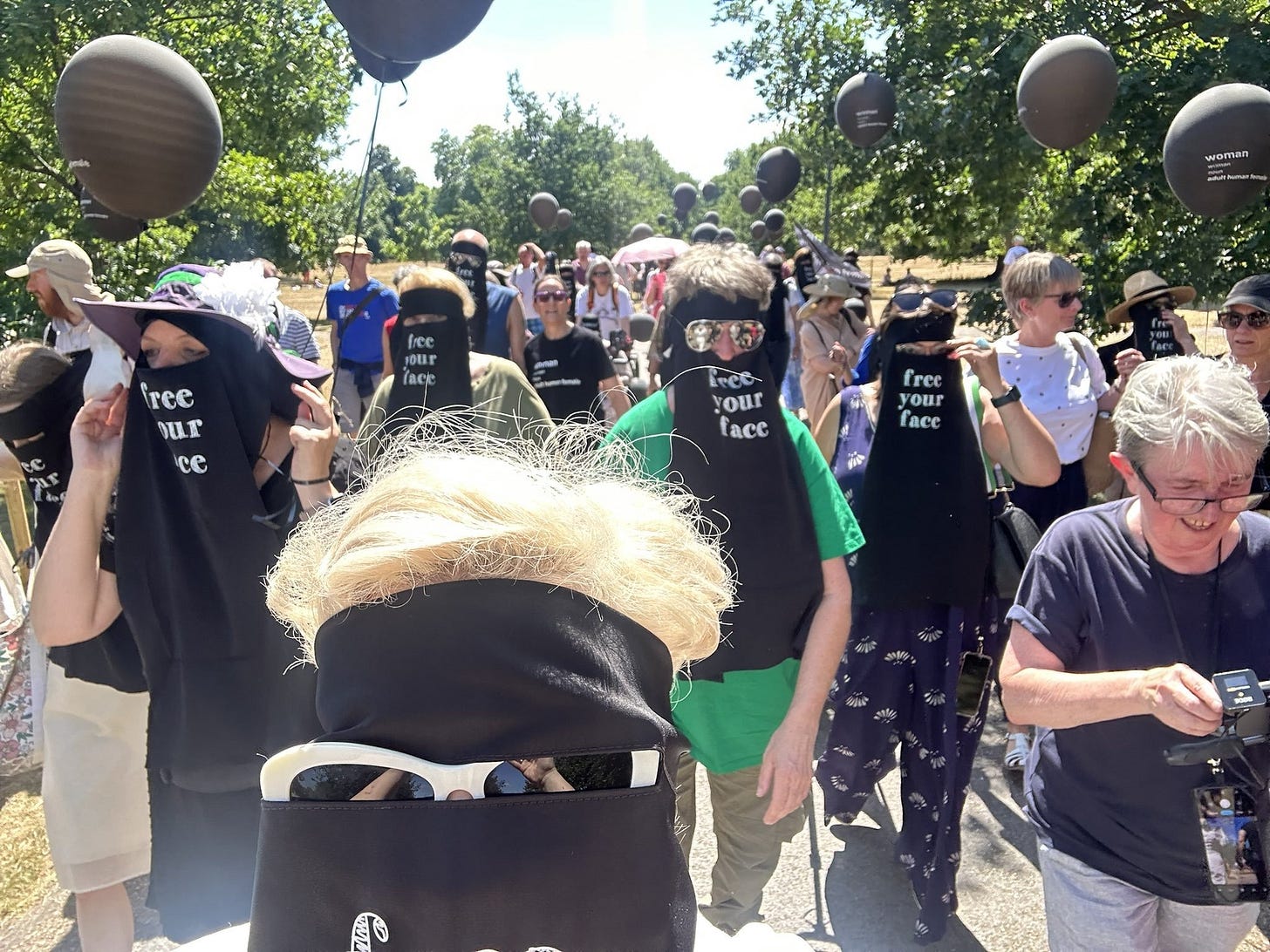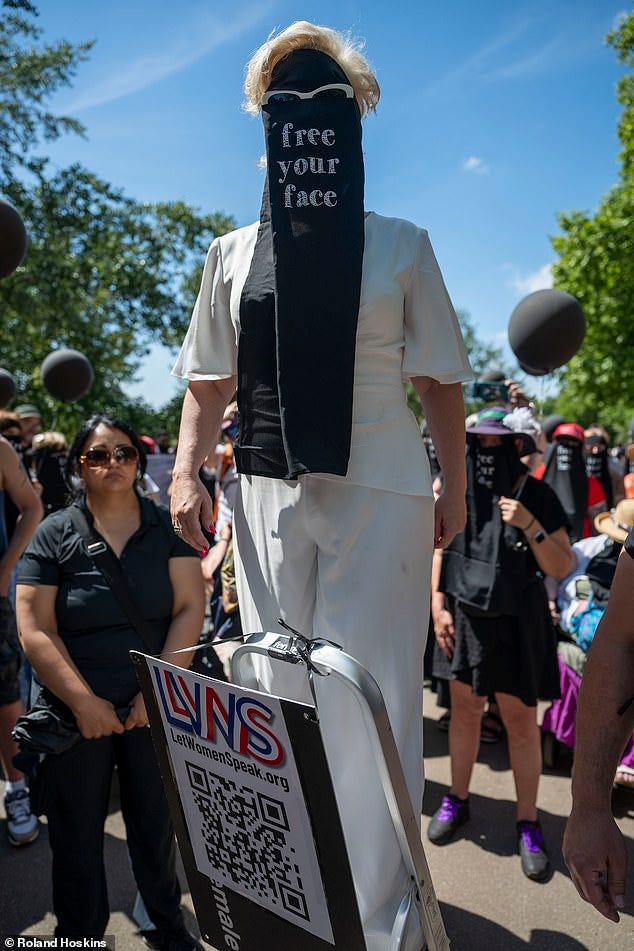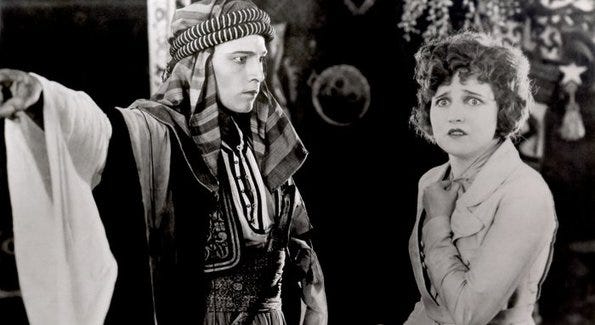
We need to be vigilant about the rhetoric of saving people because it suggests a superiority that entitles us to intervene in the lives of others.
—Lila Abu-Lughod, Do Muslim Women Need Saving?
Let Women Speak held a Free Your Face demonstration in London’s Hyde Park this past Sunday, led by founder Kellie-Jay Keen. Around 75 people gathered at the Reformers’ Tree and marched to Speakers’ Corner. Several wore black, niqab-style masks emblazoned with the slogan Free Your Face, which they then ripped off—presumably to inspire Muslim women around the world to do the same. Billed as a gesture of solidarity with Muslim women who, according to Keen, “live in a fabric prison” and “cannot speak for themselves,” this spectacle seemed, to me at least, to be part white nationalist propaganda in women’s rights drag and part white woman’s burden fantasy.
More than just an opposition to veiling, this was a border drawing ceremony: they gathered to draw a symbolic line in the sand over what—and who—belongs “here.” Veiling, and by extension Islam, wasn’t merely framed as foreign, but as fundamentally hostile to English values. No debate!
First, I’ll introduce Let Women Speak and its founder, Kellie-Jay Keen, who rose to prominence opposing gender ideology and “trans women are women” but now seems equally, if not more, animated by nationalist fervour and the defence of “Englishness” against the perceived threat of “Islamism.” Then I’ll walk through her Free Your Face speech, highlighting its vintage Orientalism, colonial saviour fantasy, and cast of caricatures, before comparing Let Women Speak’s Free Your Face to France’s “unveiling” ceremonies in Algeria—another farcical performance of Muslim women’s “liberation” staged for the camera and an anxious colonial audience. Finally, I’ll reflect on Let Women Speak’s selective hearing and veil fixation—how both function as defence mechanisms.
Kellie-Jay Keen, also known as Posie Parker, is a prominent British activist known for her direct, no-nonsense opposition to gender self-ID and transgender ideology. Her position, which I fully agree with, is: no woman has a penis; there is no such thing as “non-binary”; and transitioning children constitutes profound abuse. In 2021, she founded Standing For Woman which became Let Women Speak, a UK-based campaign that became known for its open-mic events in public parks and city centres. Here women were invited to speak freely about how “trans rights” and the spread of gender ideology through major institutions affect women’s and children’s everyday safety, privacy, and bodily integrity. Beyond breaking the enforced, faux consensus around this issue, these gatherings are also exercises in free speech and public truth-telling.
Many gender-critical feminists bristled at Keen’s uncompromising approach, fearing it would taint the movement by attracting “far right” elements. They quickly distanced themselves from her and from Let Women Speak. In response to these attacks—particularly from “head girl” feminists—Keen declared herself a “femalist” to signal both her commitment to women’s rights and her independence from established feminist organisations and orthodoxy. Let Women Speak events have indeed drawn a broad coalition, united by opposition to gender self-identification in particular, and to gender ideology more broadly.
Her single-issue campaign has expanded to include nationalist concerns about immigration and the incompatibility of Islam with English values. Her aversion to Islam is nothing original; it echoes posh thug and wannabe Christopher Hitchens—Douglas Murray’s rehash of Samuel Huntington’s “clash of civilizations” thesis and is part and partial with the populist-right zeitgeist, which frames “Islamism” as a national security threat, hostile to secularism and fundamentally opposed to women’s rights.
Keen calls for the niqab to be banned. She sees the practice as dangerous, anti-social and indecent. The niqab, for her, is a threat to our way of life, a visual offense to Englishness. “We don’t do that here,” she reminded the likely fewer than 0.5% of Muslim women who wear the niqab in the UK during Free Your Face. It’s not hard to imagine Keen’s next campaign slogan: “England for the English” or “Make England English Again.” A Free Your Face billboard and merch drop seems inevitable.
Kellie-Jay Keen has chutzpah—and an eye for political theatre. She knows how to hold a crowd and provoke a reaction. Her flair for marketing and campaigning is undeniable—and many ethnic English, Irish, Welsh, and Scottish people likely do share her anxieties about the scale and character of recent demographic shifts. According to the last census, nearly 7% of England’s population identifies as Muslim. But one has to wonder how sound her convictions really are if they depend on the demonisation of Muslim men and the infantilisation of Muslim women, rather than a genuine appeal to shared norms or civic cohesion. Why resort to stoking moral panic?
Keen’s Speech
“This is an act of solidarity with all of the women who have written to me who have to live behind the veil because their husbands, their cousins, their brothers are too weak to enable those women to be free. So, we are now going to do the thing that all of those women cannot do, which is to tell you to shut the fuck up.”
In Keen’s speech, Muslim women are portrayed as passive, voiceless, and trapped by family, culture, and male insecurity. The veil is a “fabric prison,” and the women behind it are posited as unable to speak, act, or even “feel sunlight on their skin” without male permission. Their desires, commitments, and beliefs are never considered on their own terms. Instead, they are rendered legible through the eyes, imagination and political desire of Kellie-Jay.
The few “testimonies” —attributed to women in the Middle East—were anonymous, unverified, and clearly cherry-picked. It’s hard to believe that Keen’s public pronouncements on “Islamism” elicit nothing but thank-yous and confessions of helplessness. Of course, as an activist and propagandist, she’s under no obligation to include counterarguments or opposing views.1 These testimonies function as a moral shield, allowing Keen and Let Women Speak to deflect critique with the familiar refrain: “These aren’t my words…” Indeed, her X/Twitter feed is awash with anonymized grateful wards, caged in fabric. These women are cast as mute victims—unable to interpret or change their own lives—and, by implication, grateful and dependent on these liberated English roses to speak for them.
Muslim men, by contrast, are reduced to crude stereotypes and mocked. They are “tiny penis men” who cannot “control their erections” if they see a woman’s face. Keen emasculates them through ridicule while simultaneously casting them as patriarchal oppressors. They are framed as too weak to “allow” their wives and daughters to be free. Her Muslim man is a cartoon villain—serving to justify her scorn and to elevate the non-Muslim West as evolved, rational, and superior by contrast.
England—and “the West” more broadly—is held up as the bastion of freedom, secularism, and morality, but also as fragile, under siege. Public space, and thus “our way of life,” is portrayed as being encroached upon. The niqab becomes proof that multiculturalism has gone too far—even though, again, likely fewer than 0.5% of Muslim women in the UK wear it. It’s a litmus test: to reject the veil publicly is to belong; to refuse to denounce it is to reject “England,” to reject us.
Keen’s portrayal of England and “the West” is quite defensive, both triumphalist and paranoid. It affirms English cultural superiority while stoking anxiety that this dominance is slipping away unless reasserted through symbolic and legal means. “In this country, we don’t do this.” This isn’t about Muslim women’s autonomy; it’s about marking territory.
Keen casts herself—and by extension, Let Women Speak—as brave truth-tellers and the moral vanguard of the nation. She speaks unapologetically and profanely, saying what others are supposedly too polite or cowardly to admit. Her act included several shouted “fuck yous” to Muslim men. She is self-appointed and duty-bound to model freedom and to speak for those who cannot—or will not.
But her performance was not supportive—it was substitutional. Muslim women’s (alleged) inability to speak for themselves becomes the excuse. The tone was militant, driven by symbolic emasculation and performative outrage. One doubts many Muslim women would be moved by the public demeaning and demonising of their fathers, sons, brothers and friends. In this posture, Keen becomes both rescuer and redeemer—elevating her own visibility and outrage as evidence of moral clarity and courage.
The Muslim woman that Keen—and her supporting cast, in cargo shorts and mock niqabs—conjured was a caricature: paraded, mocked, and ventriloquised. She is not the subject. She is a stage prop. Keen is the star of the show, and Muslim women exist only to serve her character arc and pivot to nationalism.
“If you're accused of Islamophobia, you're doing something right.”
For Keen, “Islam is not a religion, it’s a system designed to suppress thought.” Islam becomes not just foreign, but an existential threat to be confronted. The veil is its most visible—and thus most intolerable—symbol. Resistance to it is reimagined as a defence of Englishness. The normalisation of veiling, she warns, threatens not just women’s rights but England itself.
The climax of her performance was the symbolic confrontation between the civilised and the savage. Keen cursed and mocked her imagined Muslim patriarch, performed the ritual unveiling, and claimed victory. Her final message to Muslim women was: “Free your faces, ladies. Don’t be fucking ridiculous.”
Old Wine, New Bottle: Orientalist Redux
Keen’s speech cast familiar roles: the victim (Muslim women), the villain (Muslim men), the brave truth-teller (herself), and the moral measure (English values). Free Your Face was essentially a re-enactment of the colonial white man’s burden fantasy—the mission to civilise the “savages.” It recycled many of the tropes Edward Said identified in Orientalism, his seminal study of how “the West” portrayed “the East” in art and literature during the colonial period. Take, for example, The Sheik (1919), a novel by English writer Edith Maude Hull. It tells the story of Diana Mayo, a spirited Englishwoman abducted by the desert sheikh Ahmed, setting the stage for a melodrama of power, submission, cultural clash, and romance.
Where colonial travelogues and harem portraits invited Western audiences to indulge in fantasies of eroticised submission, Free Your Face invites them into prisoner-and-liberator fantasies. The niqab functions as both threat and fascination. The woman behind the veil exists only insofar as she reflects back what Let Women Speak desires. Her voice registers only when she speaks English and says what the anti-Islamists want to hear. The rest of the time, she is posed, mimed, caricatured.
During the Algerian War of Independence (1954–1962), French colonial authorities staged public “unveiling ceremonies” to showcase the supposed emancipation of Algerian women and their embrace of French values. These orchestrated performances, often featuring French officers’ wives unveiling Algerian women, were framed as spontaneous awakenings. In reality, many of the women were coerced—or had never veiled to begin with.
Free Your Face followed the same colonial logic. English women donned niqab-style masks, then triumphantly removed them before an approving crowd. Apparently, they couldn’t find a single Muslim woman willing to unveil for them. The veil remains a projection screen for national identity crises and imperial anxieties. This fantasy of “freeing” women from their “fabric prisons” belongs to a long history of colonial unveiling—political theatre masquerading as solidarity.
Muslim men are depicted as the same degenerate despots colonial administrators once imagined: sexually weak, emotionally unstable, and violently controlling. Keen mocks them, casting them as both laughable and a threat. These figures are not real; they are plot devices.
England, meanwhile, is positioned as the universal standard of freedom. Liberation, in this fantasy, must look, speak, and dress like a secular Englishwoman. Anything else is not simply different—it is dangerous. This is the colonial, Orientalist redux: “the East” (Islam) as backward, irrational, and sexually repressive; “the West” (England) as modern, rational, and morally superior; the Muslim woman as victim; Western woman as free.
Free Your Face cloaks its cultural policing in the language of women’s rights. This, too, has precedent. The veil became a political obsession during the colonial period—not because it mattered to European powers per se, but because it represented what they could not understand. The insistence on unveiling was a demand for legibility, to submit to their norms. Colonial authorities repeatedly used the veil as a barometer of modernity and as evidence of Muslim inferiority—justifying occupation and “civilising” intervention. White men saving brown women from brown men was official policy.
In A Dying Colonialism, Frantz Fanon addressed the French obsession with unveiling, “if we [the French] want to destroy the structure of Algerian society, its capacity for resistance, we must first of all conquer the women... we must go and find them behind the veil.”
To unveil was to make visible; to make visible was to make governable. And if the woman behind the veil refused that visibility, she became a problem to be solved—by education or force. This logic endures. Free Your Face cloaks its cultural policing in the language of women’s rights. But it repeats the same Orientalist gesture: English women, standing in Hyde Park wearing a mock niqab, demands their Muslim counterpart to “free your face” for England!
The faux niqab was a visual gag, a prop for secular condemnation. This wasn’t about support—it was about mockery. Like all moral pageants, it wasn't really about the real or imagined suffering or liberation of the veiled woman—it was about the gratification of those participating, and those watching. There are clear minstrel show vibes: an exaggerated parody where a marginalised subject is portrayed by others—flattened into a costume, a symbol, a performance. This was a Rule Britannia farce in women’s rights drag. It was Veilface.
This display wasn’t about solidarity with Muslim women. It was a parade of moral self-congratulation—a cathartic, theatrical venting of cultural anxieties and a displacement of contradictions onto the figure of the veiled Muslim woman. Once again, women are pressured to conform to dominant Western norms of intelligibility. The fantasy that Muslim women must be rescued—unveiled—to reflect the English (or French, or American) idealised image of itself is not new. Veilface is a Orientalist reboot.
Let Women Speak’s Selective Hearing and Veil Fetish
Let Women Speak claims to stand for women’s rights and free speech. But when it comes to Muslim women, they have a serious selective hearing problem. There is no meaningful attempt to understand veiling as a complex, situated practice—one that can be religious, cultural, political, familial, or personal. Nor is there any effort to recognise British Muslims, including the minuscule number who wear the niqab, as part of the national fabric. Instead, the veil is held up as a visual marker of irredeemable otherness—a threat to the imagined moral and cultural coherence of England. Muslim women are no monolith. The meaning of the veil has a diverse geography and history.2 There is no consensus, no lock-step behaviour, no uniformity in the practice—whether in the UK or anywhere else.
Finally, one must wonder: does Let Women Speak protest too much? Is this hyperfixation on the niqab and Islam a defence mechanism—what psychoanalysis calls a fetishistic disavowal? As the genocide in Gaza, the pogroms in the West Bank, and the UK establishment’s steadfast material support for all of it become impossible to deny or excuse, the fixation on the veil and the demonisation of Islam intensify. In this way, the obsession with veiling performs a double function. It stages Western chauvinism as care, while allowing anxiety over imperial violence to be projected outward—onto the figure of the trapped Muslim woman and the evil Muslim men who keep her in a “fabric prison.” They fixate on the veil to avoid confronting their complicity.
For one example, Dalia Mogahed & John Esposito, Who Speaks for Islam? (2007) Provides global polling data showing the reasons women cite for veiling, often linked to identity and piety, not submission or male coercion.
Saba Mahmood, Politics of Piety: The Islamic Revival and the Feminist Subject (2005); Fatima Mernissi, The Veil and the Male Elite: A Feminist Interpretation of Women's Rights in Islam (1987); Leila Ahmed, Women and Gender in Islam (1992); Joan Wallach Scott, The Politics of the Veil (2007); Helen Watson, “Women and the Veil: Personal Responses to Global Process.” in Islam, Globalization and Postmodernity (1994).









A painfully superb critique.